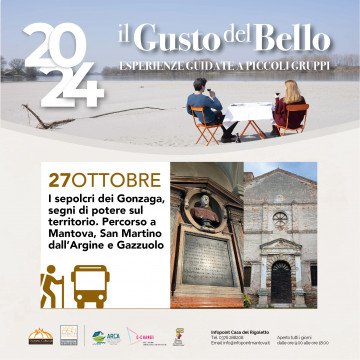I sepolcri dei Gonzaga, segni di potere sul territorio
Informazioni rapide
Tempo libero
Tipologia
MANTOVA
Citta
Piazza Sordello
Luogo
24/10/2024 - 24/10/2024
Data inizio - fine
ore 14.30
Orario
Descrizione
I sepolcri dei Gonzaga, segni di potere sul territorio
IL GUSTO DEL BELLO, PRIMO PIANO
 Percorso a Mantova, San Martino dall’Argine e Gazzuolo
Percorso a Mantova, San Martino dall’Argine e Gazzuolo
I sepolcri e i mausolei dei Gonzaga rappresentano contemporaneamente due aspetti: da un lato preservano la memoria dei regnanti e dall’altro legittimano il potere dei loro discendenti.
L’itinerario inizia in Duomo a Mantova dove scopriremo quali importanti personalità della casata furono sepolte qui, e proseguirà all’oratorio di San Pietro a Gazzuolo e alla Chiesa dei Santi Fabiano e Sebastiano a San Martino Dall’Argine, mausolei dei rami cadetti.
Nel percorso è compreso lo spostamento con autobus privato.
RITROVO
Piazza Sordello – Mantova, di fronte all’ingresso di Palazzo Ducale
PERCORSO
Il Duomo di Mantova, la Chiesa dei Santi Fabiano e Sebastiano a San Martino Dall’Argine e l’oratorio di San Pietro a Gazzuolo.
CONTRIBUTO
euro 15,00 a persona
iscritti Fai e bambini dai 6 ai 12 anni 12 euro, gratis minori di 6 anni.
Per prenotare
Infopoint Casa del Rigoletto
Tel. 0376 288208
Email: [email protected]
Aperto tutti i giorni
dalle ore 9.00 alle ore 18.00